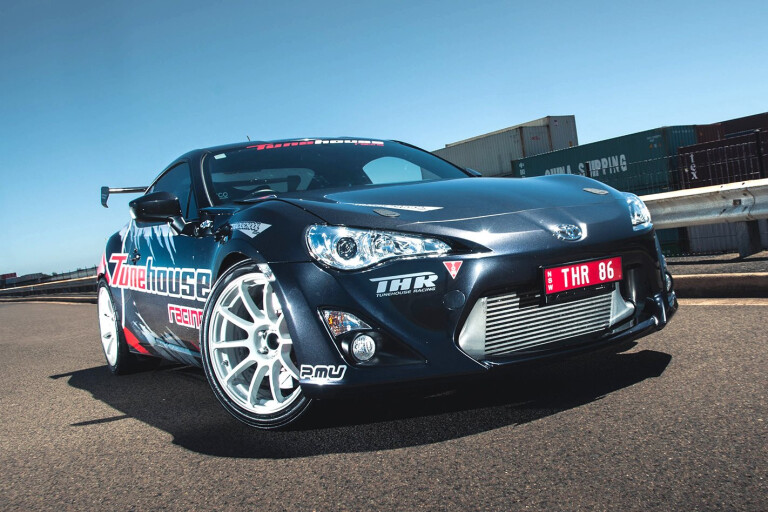
Claiming the crown of ‘Australia’s fastest or most powerful anything’ is a bold statement.
But clocking the fastest lap time for an Toyota 86 or Subaru BRZ at the Yokohama World Time Attack Challenge – Australia’s annual tuner slugfest at Sydney Motorsport Park – goes a long way to certifying such a boast.
Tunehouse’s supercharged Toyota 86, nicknamed THR-86, took only 1min 44.92sec, in the hands of some-time MOTOR cohort, John Boston, to score what no other Toyobaru could match.
And right now it’s sitting in Sydney gridlock, a 37 degrees Celsius summer heat turning the winged coupe into a pizza oven and yours truly into a Super Supreme because the air-con doesn’t work. Well, the oily bits required do, but are probably in a box labeled ‘unnecessary’ at Tunehouse.
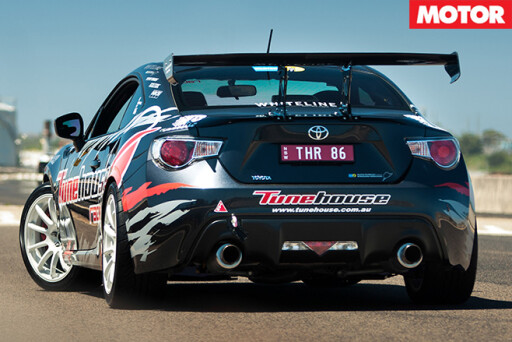 Hunkered down over fat 19-inch rolling stock, warpaint and carbonfibre glistening in the heat haze, and its force-fed 2.0-litre boxer growling through a stainless steel exhaust, this hyper 86 looks like a WTAC winner. On Sydney’s mean streets, it’s about as conspicuous as an alien spacecraft in Martin Place.
Hunkered down over fat 19-inch rolling stock, warpaint and carbonfibre glistening in the heat haze, and its force-fed 2.0-litre boxer growling through a stainless steel exhaust, this hyper 86 looks like a WTAC winner. On Sydney’s mean streets, it’s about as conspicuous as an alien spacecraft in Martin Place.
And yet the big surprise is that, despite a bitey Xtreme twin-plate clutch and a slight clunk in the Tomei two-way LSD rear end, it’s almost as docile in the urban crush as the stock sportscar it once was.
Tunehouse has owned the 86 since the first of the freshly-minted Toyota’s landed in 2012, and it quickly became an R&D test bed for the Marrickville shop’s go-faster brands, including Japan’s famed HKS. It’s been on a long and carefully orchestrated path to become the beast it is today, each step crucial in developing the various aftermarket gadgets Tunehouse markets for the 86 and its Subaru twin, the BRZ.
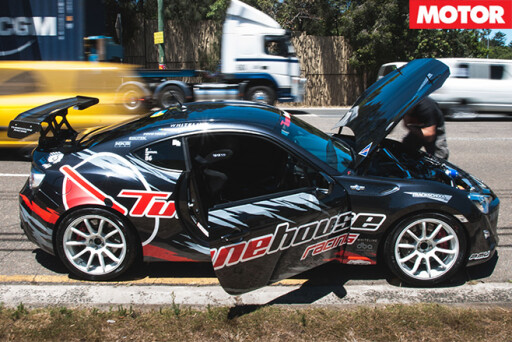 “The car has been through all three of our packages,” Tunehouse boss Jim Ghelis explains. “We started with the THR (Tunehouse Racing) naturally-aspirated 160kW/188Nm Spec S ‘Street’ and 165kW/198Nm Spec C ‘Competition’ kits prior to going to the Spec R ‘Racing’ forced-induction package.” The Spec R’s centrifugal supercharger set-up yields a handy off-the-shelf 225kW and 265Nm.
“The car has been through all three of our packages,” Tunehouse boss Jim Ghelis explains. “We started with the THR (Tunehouse Racing) naturally-aspirated 160kW/188Nm Spec S ‘Street’ and 165kW/198Nm Spec C ‘Competition’ kits prior to going to the Spec R ‘Racing’ forced-induction package.” The Spec R’s centrifugal supercharger set-up yields a handy off-the-shelf 225kW and 265Nm.
In current WTAC guise, though, THR-86 swings a bigger stick. Despite running a modest 0.6bar (8psi) of peak boost and standard engine internals, the engine now produces around 300kW. Ghelis calls it Spec R ‘Plus’, and it’s only for competition use, and not a bolt-on customer package.
Why? Well, it’s not for lack of public road drivability, in fact, the opposite. The engine now feels about on par with a 2.5-litre turbo STI boxer but unlike the Subie engine, throttle response is crisp, response off-idle immediate, and it’s so razor sharp in the mid-range it demands concentrated precision from your right foot.
 And yet, in great supercharger tradition, it delivers its formidable output in an incredibly linear fashion. It revs as freely as a race engine, yet delivers more torque at 2500rpm than the standard engine does at its peak and pulls hard right to its 6500rpm power peak. It’s almost like a large-capacity atmo engine. It’s brilliant.
And yet, in great supercharger tradition, it delivers its formidable output in an incredibly linear fashion. It revs as freely as a race engine, yet delivers more torque at 2500rpm than the standard engine does at its peak and pulls hard right to its 6500rpm power peak. It’s almost like a large-capacity atmo engine. It’s brilliant.
The key to screwing extraordinary pace from the 86/BRZ breed, as Tunehouse preaches, isn’t purely down to output gains, but in maintaining balance among all areas of a complete go-faster package. Rewind two years, handling and grip were the first things Tunehouse chased for THR-86.
“Out of the box, the 86 has a fantastic chassis but is underpowered,” says Ghelis. “Still, we focused on tyres and suspension (upgrades) to see what the chassis is really capable of. Only then could we chase power, to balance the equation out.”
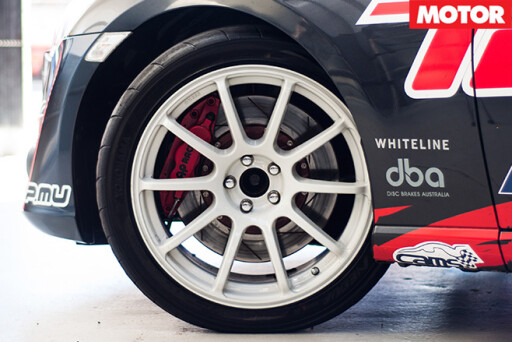 Being methodical paid dividends. Just swapping the stock Prius tyres for hi-po Toyo Proxes R888s netted a lap time gain of over two seconds at the 86’s first R&D outing at Wakefield Raceway.
Being methodical paid dividends. Just swapping the stock Prius tyres for hi-po Toyo Proxes R888s netted a lap time gain of over two seconds at the 86’s first R&D outing at Wakefield Raceway.
Tein Monoflex coil-overs, Super Pro suspension, upgraded DBA rotors with THR Clubsport pads, and an HKS Spec L exhaust system completed the initial ‘lightweight’ tuning combination, with a Spec S engine kit added prior to THR-86’s appearance at MOTOR’s own 2012 Hot Tuner Challenge.
By the time the 86’s first birthday rolled around, the Spec R supercharger kit with THR’s custom Ecutek ECU tune, and four-pot front brakes were installed and Boston had the Toyota flying around Wakefield, in 1min 7.9sec, a full 5sec quicker than standard. Tunehouse now claims it’s the quickest 86 ever to lap Wakefield.
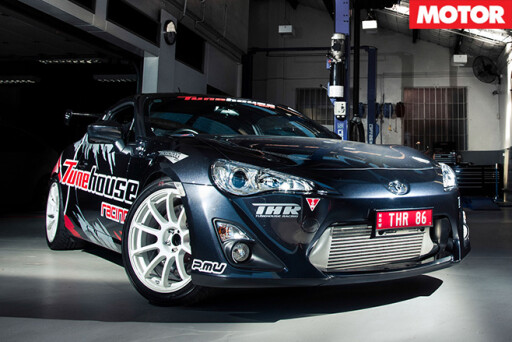 “After our Spec R kit was installed, we pushed development using E85 fuel,” Ghelis says. “A Flex Meter, which feeds an output to the factory ECU, allows us to vary the blend of E85 and 98RON fuels.
“After our Spec R kit was installed, we pushed development using E85 fuel,” Ghelis says. “A Flex Meter, which feeds an output to the factory ECU, allows us to vary the blend of E85 and 98RON fuels.
When we first went from 98 to E85, power jumped from 222kW at the flywheel to 279kW! Since changing to E85 for racing, we haven’t turned back.”
Tunehouse then pushed suspension development, switching from Tein to custom Bilstein B16 coil-overs, installing Whiteline bushes, swapping rear camber arms, adding custom strut tops and changing geometry. With handling sorted, they sourced wider 9.0-inch Rota rims and Yokohama ADO8R tyres then went for even more grunt.
 Stopping power was improved by massive AP Racing six-piston front and four-piston rear brakes with Project MU pads and fluid. The driveline was uprated and modest aero tweaks added. The WTAC bug had bitten hard.
Stopping power was improved by massive AP Racing six-piston front and four-piston rear brakes with Project MU pads and fluid. The driveline was uprated and modest aero tweaks added. The WTAC bug had bitten hard.
“Once we decided to enter WTAC, we really took a different approach with the 86,” Ghelis says. “Custom parts were ordered, others were fabricated and we began modifying the HKS GT Supercharger kit.
” In dyno testing, the engine was pushed to a stratospheric 381kW at the flywheel (at just 0.7bar) but detuned to ‘just’ 300kW for WTAC reliability. That’s still twice the factory power rating using standard internals.
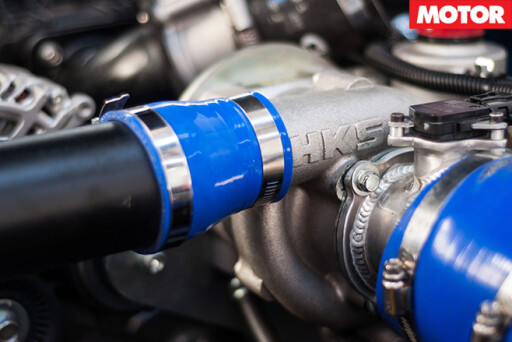 “Anywhere over about 250kW the engine should be strengthened (internally),” Ghelis reckons. “We’ll be looking at rods, pistons, studs, gaskets, cams and reviewing compression in future. But the standard engine will cope with big power provided it’s tuned properly.” And the rest?
“Anywhere over about 250kW the engine should be strengthened (internally),” Ghelis reckons. “We’ll be looking at rods, pistons, studs, gaskets, cams and reviewing compression in future. But the standard engine will cope with big power provided it’s tuned properly.” And the rest?
“The standard ’box is holding up fine, though the clutch needs replacing beyond about 200kW. We put in a two-way LSD because sometimes on track, the car can lift onto two wheels across the kerbs and we want as much traction as possible, even when this happens.”
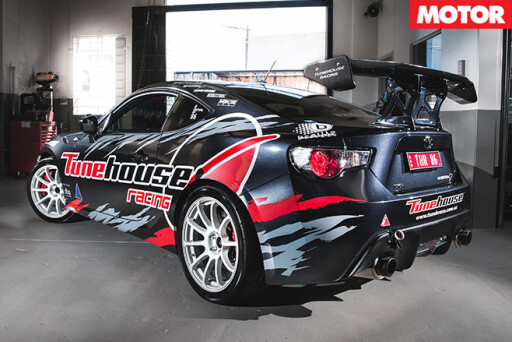 The suspension, stiff by road standards, is perfectly streetable. “We tested a lot of different set-ups, geometry, bracing and combinations before arriving at this spec,” says Ghelis. “A lot of bolt-on mods and alignment settings actually made the car slower and off-balance. And it’s better to have more brakes than less mentality.”
The suspension, stiff by road standards, is perfectly streetable. “We tested a lot of different set-ups, geometry, bracing and combinations before arriving at this spec,” says Ghelis. “A lot of bolt-on mods and alignment settings actually made the car slower and off-balance. And it’s better to have more brakes than less mentality.”
But compared to a street 86, this device is mental; it’s a race car with rego plates, albeit one that’s happy at sane speeds or even in insane summer gridlocks. That said, Tunehouse wants more power, grip, aero and quicker lap times and have plans to source an 86 shell and build a dedicated WTAC car from scratch. We’ll be waiting.

COMMENTS